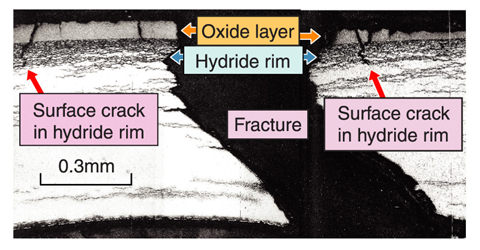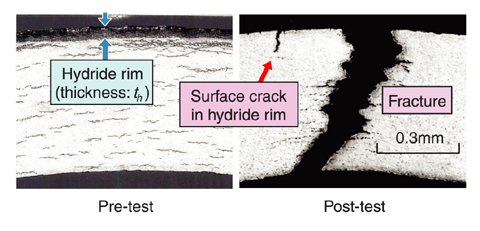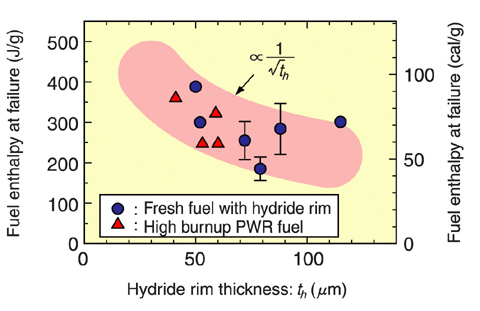
Fig.5-4 Cross-section of high burnup PWR fuel clad which failed in the NSRR test

Fig.5-5 Failure of fresh fuel with artificial hydride rim

Fig.5-6 Relation between hydride rim thickness and fuel enthalpy at failure
Extending the fuel utilization period in light water reactors, i.e. fuel burnup extension, is being promoted for more efficient use of the uranium resource and so on. The long-term use, however, increases the fuel clad corrosion and fission product accumulation in the fuels. Hence, the safety of burnup extension should be confirmed under accident conditions as well as under normal operation conditions. To determine high burnup fuel behavior and failure conditions in a Reactivity Initiated Accident (RIA), we have performed RIA-simulating power burst tests at the Nuclear Safety Research Reactor (NSRR).
Fig.5-4 shows a cross-section of the PWR fuel clad, which failed due to pellet thermal expansion at a power burst in the NSRR test. High burnup fuels typically have an oxide layer at the clad outer surface due to long-term contact with coolant water. As the hydrogen generated in the surface oxidation process was absorbed into the clad, the excess hydrogen precipitated mainly under the oxide layer and formed a " hydride rim" which is not as fragile as the oxide, but has higher brittleness than the normal regions.
Previous studies showed that the fuel can fail at lower fuel enthalpy, i.e. with smaller pellet expansion, when the clad oxide is thicker. The present study, however, focused on the influence of the hydride rim rather than the oxide layer, and performed RIA tests using a fresh fuel rod with an artificially produced hydride rim only. Fig.5-5 shows examples of the pre- and post-test clad cross-sections. The fracture shape and surface cracks observed in the case of the high burnup fuels were reproduced, indicating that the hydride rim plays a key role. In the relation between the hydride rim thickness (th) and the fuel enthalpy at failure in Fig.5-6, results from the two test series show a consistent tendency of fuel enthalpy at failure being in inverse proportion to the square room of th. This curve can be explained as being due to the stress intensity factor at the surface crack tip, if the crack depth is regarded as th. Thus, it is suggested that the surface cracks in clad hydride rim are generated in the early stage of RIA, and one of them grows due to the stress concentration and results in a fracture. The knowledge obtained from this study will be reflected in advanced safety evaluation methods for RIA.